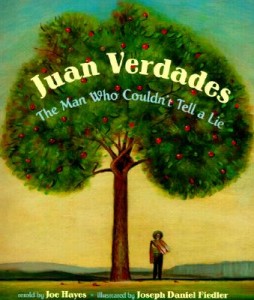 Retold By: Joe Hayes
Retold By: Joe Hayes
Illustrated By: Joseph Daniel Fiedler
The story of Juan Verdades is retold in a strong, traditional style. It is longer and goes more in depth than most current picture books, and it is beautifully written. Unique illustrations add a distinct, vibrant style of art to the story. The voice of the author transports the reader to past, where stories were events that were shared with all who would listen.
Juan is a simple man who tends the famous apple tree of a well-respected ranchero. He is so honorable that it is believed he is incapable of telling a lie. Thus a wager is made to prove the proud ranchero wrong about his faithful employee. As the plot thickens, the virtues of Juan and the ranchero pull the reader into the fierce hope that when given the chance, honesty will prevail.
When you read this book, do not skip the “Note to Readers and Storytellers” at the end. The history of the story is a walk through the progression of storytelling, and an example of how words that affect people can last far longer than their creators ever could have imagined.
Discussion/Project Ideas:
1. Juan’s answer to don Ignacio is a complicated one. Learning to write within certain restrictions can be challenging. Can you rewrite Juan’s response, while still answering the question with honesty? Try it out with a partner and see if they can puzzle out your response. Make up new questions that it would be tempting to lie about and see how tricky you can get with your honest response. Remember not to do this with your parents and teachers!
2. For this activity, I wanted to have students evaluate how well this story exemplified the characteristics of a good story. To make sure I had a proper and complete list, I researched “story characteristics” online. As a former teacher, I don’t remember there being such a wide variety of lists! Therefore, I challenge your students (before you read the story) to create a list of six or seven characteristics they believe a good story possesses. After reading, have your students individually evaluate how well this story addressed each characteristic. Share with the class and compile them into a final, group list.
3. After completing the above activity, (on different days) read other books that are written in a “storytelling” format. Evaluate them with the same list of characteristics. As a group, compare the individual lists and make a class chart of the responses. See if changes need to be made to the evaluation list. Did the criteria (their six or seven characteristics of a good story) change? Did you add to the list? Keep these characteristics posted in the room and throughout the year revisit them with new books. Try new genres and see if they fit. Don’t be afraid to alter your list if the reasoning is sound (as determined by the readers themselves).
